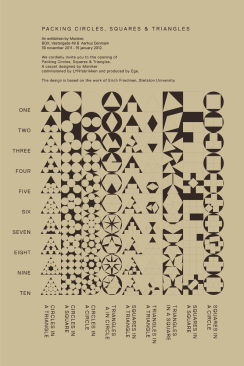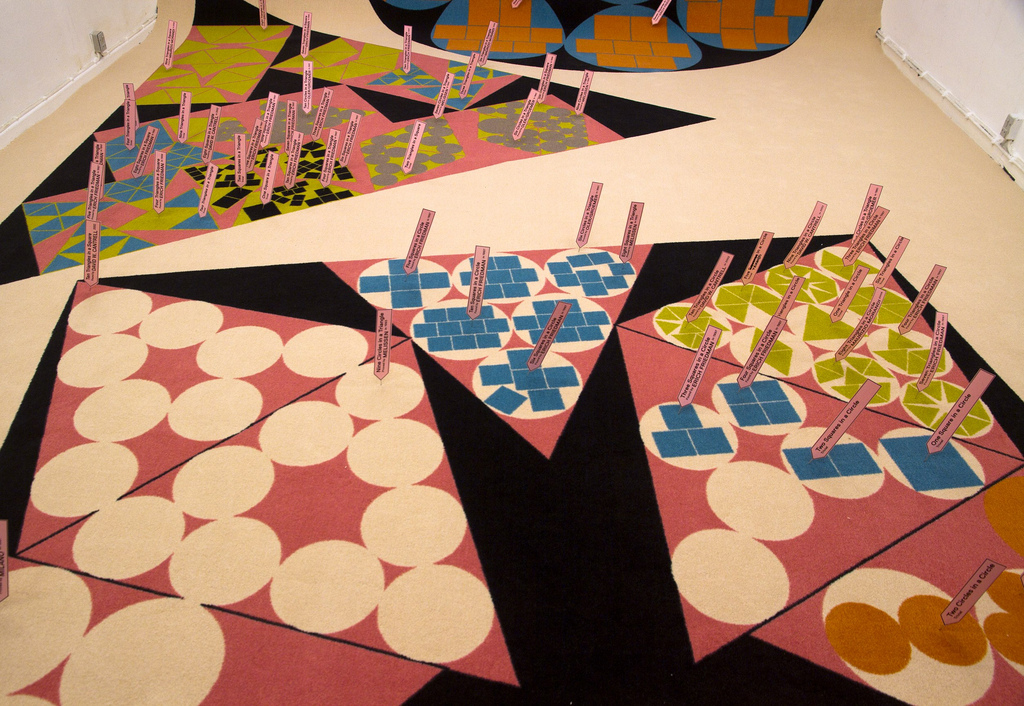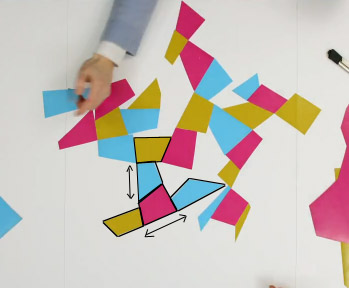Packing Problems
An exhibition by Moniker.
BOX, Vestergade 49 B Aarhus Denmark
We designed a carpet based on work of Erich Friedman, Stetston University.
Commisioned by LYNfabrikken and produced by Ege.
If you want to pack the biggest possible circle in a square you can probably imagine what it looks like, but how about packing seven equally sized circles in a square? How would they be organized? How about packing 10 squares packed in a square? How would you fit them?
Erich Friedman, Associate Professor of Mathematics at Stetson University Florida has made a beautiful overview of scientific solutions to these 'packing problems'. Most of them are symmetrical and make sense immediately but sometimes they are far from obvious. We took these beautiful solutions and turned them in a colorful carpet.
Convex City Plan
The idea of this workshop was to create a big intriguing colored pattern for renovated houses with white walls. The size was therefore as big as the table. This time we also didn't want to use a pen, we used old big letraset stickersheets instead.
General:
- Every player receives one color sticker sheet.
- The growing pattern consists of branches - of which each branch is created with a pair of three polygons - one of each color.
In turns:
- Cut a convex quadrilateral (a polygon with four sides) from the sticker sheet
- Attach it to an existing quadrilateral.
- Attach it so that a pair of three quadrilateras forms together one edge that is as straight as possible.
- A branch must not contain more than one quadrilateral of each color.
Today we tried to modify and examine they way we speak. Usually everyone has their 'way of talking' in a discussion or just in a normal conversation.
After generating the frame, we chose to speak about what kind of introduction we should have for the Conditional Design publication we are working on right now.
We recoded our conversation and transcribed it - read below. Unfortunately in Dutch.
Construction of the Frame
- Participants: In our case we were three people - Jonathan Roel and Luna.
- Every participant gets another participant appointed as a partner.
- Lead a conversation.
- During the conversation the partner has to note (in a text document) one word from each sentence of his 'master'. He is supposed to note the words that he finds interesting, specific or remarkable in some way. The notation will say something about both - the one noting the words as well as the one who speaks.
- Conversation: Speak about "What do you think Conditional Design means to other people."
- The conversation should last ca. 20 - 30 minutes.
- At the end of the conversation each participant has a list of words he used noted by his partner.
Playing with the Frame:
- Exchange the list of words you just created and take a list of words of someone else.
- Start anoter conversation with a topic that is close to you.
- When you speak use at least one word of your list per sentence. Use the words in the order of the list starting from top.
- Speak slow and construct your sentences so that they make sense. It is very funny because one has to express something in a sometimes quite complicated way in order to incorporate the words from the list.
In de Knoop
For the last in the series of contributions to Items magazine, we decided to redo the knots workshop.
- First Step:
- The first player draws a line.
- The other players draw a line that goes over and under the last drawn line.
- In Turns:
- The player elongates his/her line on both ends. The elongations have to go over and under a line of another player and may not go over the line of the same color twice in a row.
- When a line can no longer be elongated, it is considered dead for the rest of the game. When both ends of a line have died, the player may place a new line.
Primordial Soup
Try to draw all combinations of triangles within a growing amount of points.
- In turns:
- Start by placing 3 points on the paper.
- Connect all points with 1 line.
- You may not go back over the same line.
- You may only cross the line on one point.
- Hatch your shape if it wasn't drawn before.
- If there weren't any new shapes found in the last 3 rounds, one point may be added.















